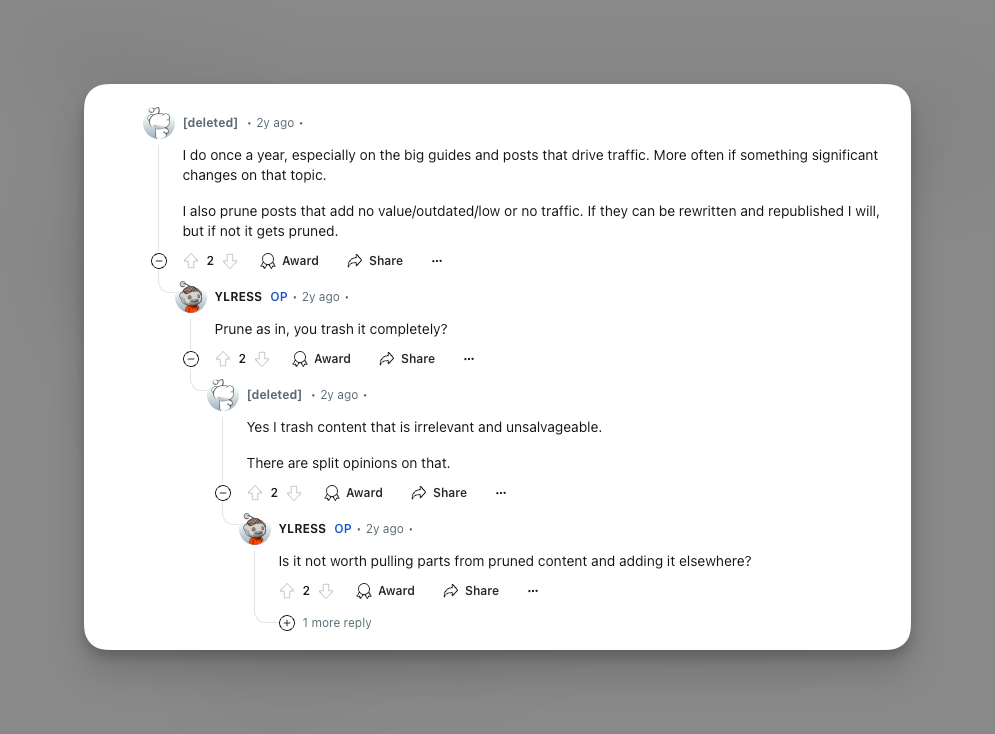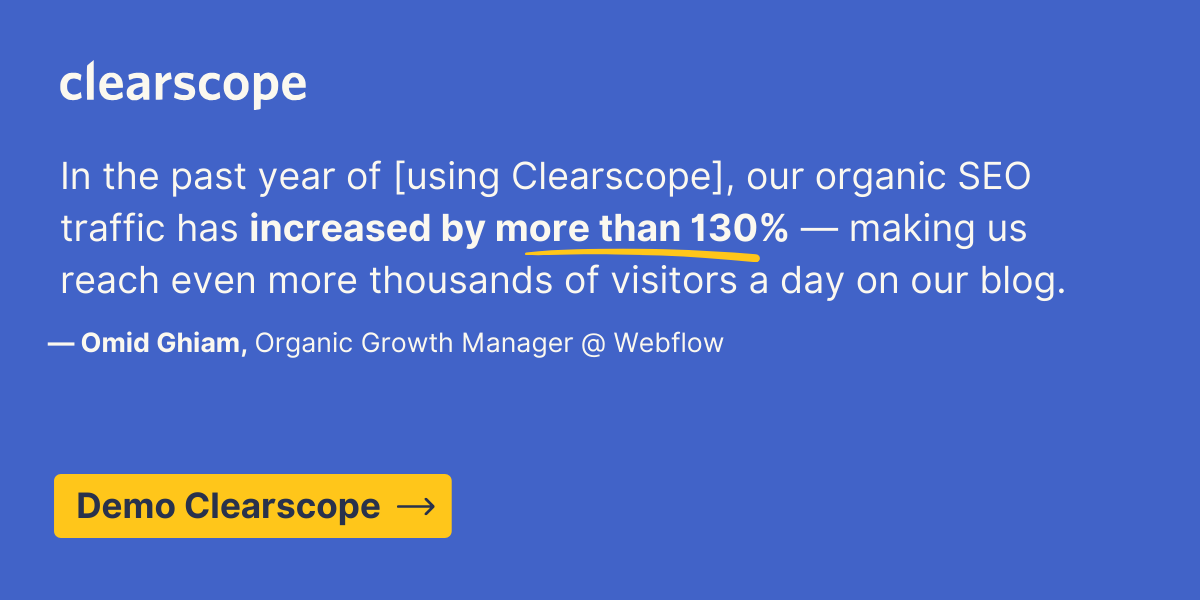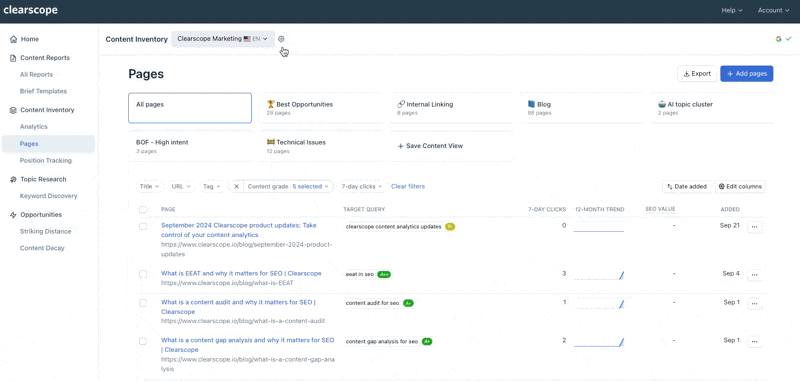How Often Should You Do Content Pruning?
Topic: Content Marketing
Published:
Written by: Bernard Huang
Keep your SEO strategy sharp with regular content auditing.
Let's talk about how often you should be doing that.
To be honest, I don’t like content pruning. At all.
The mischievous side of me would love to answer the question of How often should you do content pruning? on one of those LinkedIn community articles with NEVER. DON’T DO IT.
I’ll refresh an article experiencing content decay or enjoy consolidating multiple pieces any day, but digging into an entire content library and deciding what to keep and what to delete or repurpose can be a headache.
At the date of this writing, I have just wrapped up several days of completing a content pruning project for the Clearscope content library.
And let me tell you, cleaning up all those null-and-void internal links can be a time suck if you’ve kept your content pruning process on the back burner for a while.
New content or refreshing underperforming content often takes priority in a content strategy, but crucial SEO and content hygiene practices, like content pruning, can often be... ahem... forgotten and left behind.
Which is why it’s essential to incorporate content inventory pruning into your regular content management to maintain your library’s overall health.
Picture this: If you’ve got 250 pages of content live, but 125 of those don’t receive any traffic at all, what is Google going to think? That half of what you produce is poor? That your content isn’t giving off that shining shimmer of trustworthiness and relevant information gain?
That’s not a risk I’m willing to take with a client’s content library, despite how much of a pain it can be to review old content with a fine toothed comb.
Plus, those crawlers and bots aren’t infinite in number, and you need to trim the dead weight of low-performing content—while also maintaining the health of your quality pages—to make the most of your crawl budget.
READ MORE: Need a step-by-step content pruning guide? This isn't it. Check out How to do content pruning to boost SEO performance instead.
How often should pruning be done and why?
Content pruning is not a one-and-done process. Even if you don’t need extensive pruning (like with an initial attempt), you may still need to prune your website content from time to time.
Seasoned content strategists and SEO experts recommend doing so every 3-6 months—or at least once a year. And this discussion in the broader r/SEO community corroborates that.

This helpful discussion in the SEO subreddit gives some clarity at how often other SEO and content strategists are pruning content.
In my experience, I prefer to create a regular rhythm of examining content once it’s published within 3 months, and then another 6 months.
(However, for evergreen content that’s ranking well, I’ll check on it every 6 months in Google Search Console and Clearscope.)
If it’s not receiving any traffic for 6 months, I refresh and rework it.
9 months out, if it’s still not ranking and isn’t valuable for another marketing channel—it’s done.
This ensures that outdated content is removed, thin content is improved, and your SEO strategy stays on track.
WATCH: How to make the most of your content reoptimization strategy with expert SEO and content marketing strategist Maeva Cifuentes
There are several reasons to regularly do content pruning:
Outdated information can hurt your search engine optimization (SEO performance) as Google rewards fresh, high-quality content.
Changes in digital marketing trends and search engine algorithms may require adjustments to your existing content.
Shifts in your marketing strategy or target audience necessitate updates to align with your relevant content and content strategy.
Search intent for queries can change over time—if your content is not performing well and receives no traffic, it’s likely it should go.
Think about maintaining not only the content quality of each individual page, but also your library as a whole and even topic clusters as a whole.
(Watch out for the dreaded keyword cannibalization that can drag you down.)
How to reduce content pruning in the future
Content pruning can be time-consuming and energy-draining—it requires a significant time investment to review the performance metrics, internal links, backlinks, bounce rates, organic traffic and visibility, and overall quality of each page and decide to keep it or let it go.
However, there are several ways to minimize the need for extensive pruning in the future:
Create a content calendar
Be mindful about your content creation goals
Regularly audit your existing content
Keep an eye on any technical SEO issues
Monitor the health of your overall content library
Use optimization tools for content creation
1. Create and stick to a content calendar
It’s content marketing 101: The benefits of content calendars outweigh the costs of not keeping one.
Having a content calendar and a clear, outlined content marketing strategy helps you plan out your new content and avoid creating duplicate content that contributes to content cannibalization.
The calendar also becomes a handy resource during your content inventory audits, ensuring you have a record of what content is published and when.
It gives you a roadmap for creating content so that you can avoid creating irrelevant and duplicate content.
Overall, this content calendar will come in handy when you do a content audit in the future, as it provides a ready list of your articles. I like to use a simple Google Sheet log for my content calendar, inputting and changing publish dates as needed.
2. Be mindful about content creation goals
Producing content without clear goals can lead to low-performing content that you’ll eventually need to prune.
Every piece of content should serve a purpose—whether it’s boosting conversion rates, targeting pain points for your ideal customer profiles, supporting your sales and customer teams, or driving more organic traffic.
Consider identifying gaps in your content marketing strategy, such as lacking evergreen content or not having enough helpful types of content for an important topic for customers in later stages of the sales funnel.
3. Regularly audit your content
After you publish an article, keep checking it’s SEO performance in terms of:
Organic traffic and pageviews
Search rankings
Bounce rates or engagement time
Social media engagements
This regular mini-content audit will help you get an early idea of what content is performing well and what isn’t, allowing you to remove or repurpose thin content, low traffic posts, and anything else that may need updating, deleting, or consolidating.
Planning periodic audits by topics or funnel stages gives enough time to split up content pruning over time.
4. Keep an eye on any technical SEO issues
While some SEOs would argue that technical SEO doesn’t matter as much anymore (you know, meta descriptions and tags, landing pages with perfectly keyworded H1 headings, and the routine Screaming Frog crawl) technical hygiene is still important for your website’s SEO performance.
Stay on top of all those noindex tags and issues, and clean up any older meta data that could be over-optimized or misleading.
This produces a better overall user experience and keeps your web pages sparkling clean to house all that good content you’re creating.
(Clearscope can also help with this too! More on that below.)
5. Monitor the health of your overall content library
By regularly evaluating your content performance—such as tracking pageviews, bounce rates, and other key SEO metrics that are important to you—you can quickly identify underperforming content or outdated information that needs updating.
This proactive approach ensures that you maintain quality pages and keep your SEO content aligned with current standards, reducing the accumulation of low-performing content that would otherwise require pruning.
You could do this with traditional tools like Google Search Console or Google Analytics, but hey—we’ve all experienced GA4, and if you can find something simpler and more streamlined, that’s ideal.
I’ve been using the new Clearscope Content Inventory feature, along with the Custom Content Views builders, to skip GA4 altogether and group my pages by topic clusters, stages of the funnel, and so much more.
It makes maintaining high-quality content—and continuously keeping track of your content strategy—easier and keeps your content pruning strategy and efforts in check.

This has to be one of the easiest ways available to create content buckets for simplified viewing of your content analytics. It's content intelligence and monitoring, simplified.
6. Use optimization tools for content creation
Keyword research is the starting point for many strategists of creating content optimized for search engines. (I myself prefer to start at organic needs and pain points voiced by sales and customer teams, but hey, we’re all different!)
After doing keyword research via traditional SEO tools like Ahrefs or Semrush, you might find thousands of potential relevant keywords during this phase.
How do you determine the keywords that can help you rank content high on relevant SERPs—without creating duplicate content?
SEO tools like Clearscope can help you closely (and easily) monitor your content inventory and craft effective content by providing insights into keyword cannibalization, search queries, and internal links.
Clearscope can help you maximize your content’s SEO potential while minimizing future pruning needs.

How does Clearscope make a difference?
Clearscope’s robust content-first platform will help you grow and protect your brand’s organic visibility through the power of people-first content optimization.
The Topic Exploration feature helps you identify the most relevant keywords and search intents around a particular subject—and leave behind the ones that don’t matter.
And Clearscope’s Content Inventory and Custom Content views help you track and protect the health of your content over time.
Plus, with easy-to-understand alerts for technical issues found in your content library, staying on top of your content’s technical health is easier than ever.

A simplified way to see the technical errors on your most important pages. (With quick reminders of what these errors mean and how to fix them.)
Clearscope uses advanced algorithms and LLMs to help you research, optimize, and monitor your content by:
Understanding your topic using a high-end natural language processing (NLP) algorithm powered by IBM Watson and Google Cloud
Deploying an in-house noise reduction algorithm to suggest keywords relevant to your topic
Referencing millions of documents to determine how important each entity is for your content to sharply meet your target search intent
Wrapping it up: How often to do content pruning to improve your search rankings
When it comes to content marketing, the quality of your content matters more than its quantity.
Low-quality content isn’t useful for visitors and might also hurt your website’s search rankings.
Having regular content pruning practices in place helps you remove or repurpose low-quality content throughout the year, rather than letting this task build up over time.
Removing the content that represents a lot of your team’s effort might seem a bad idea at first.
But content pruning does have many benefits, like:
Improving search engine rankings by highlighting your most valuable content
Cleaning up cluttered blogs and combining similar pages
Creating a better user experience be removing dead weight
A systematic approach to content pruning is the way to ensure you don’t delete or repurpose helpful content—or leave the task on the back burner for months and months.
How to Do Content Pruning to Boost SEO Performance
Systematic content pruning helps you remove or repurpose low-quality content on your website to improve search engine rankings and user experience.
Read moreHow to Create a Content Inventory & Perform a Content Audit
Our post explains how to perform a content inventory, audit your existing website content, and maintain an SEO-optimized site — in four simple steps.
Read moreHow To Measure and Predict ROI for Your Content Marketing Strategy
Understanding how to calculate content marketing ROI is an essential step in tracking and communicating the effectiveness of your strategy.
Read more